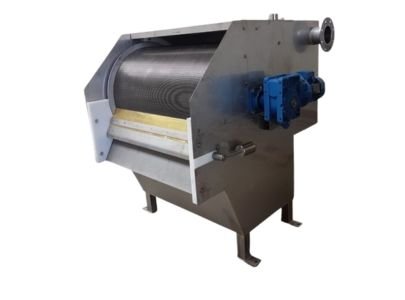The Rotary Drum Screen is an advanced fine screening solution, specifically designed to efficiently remove particles with a porosity range of 2 mm to 3 mm. This fine screening capability ensures the effective elimination of small particles such as human hair, mustard seeds, and other fine debris that could pose challenges in wastewater treatment systems.
By preventing non-digestible particles from entering downstream processes, the Rotary Drum Screen plays a vital role in safeguarding the integrity of the aeration system. This proactive screening measure significantly reduces the risk of clogging and operational disruptions, thereby enhancing the overall efficiency of the treatment process.
Furthermore, the Rotary Drum Screen is essential in protecting advanced membrane systems like Membrane Bioreactors (MBR) downstream. By blocking unwanted particles at an earlier stage, it ensures optimal performance and longevity of the aeration system and MBR membranes, while maintaining a high standard of wastewater treatment.
Engineered for reliability and efficiency, the Rotary Drum Screen is an indispensable component in modern wastewater management, ensuring uninterrupted operation and compliance with environmental standards.
- WORKING PRINCIPLE
- Influent Flow: Wastewater enters the system and flows into the rotary drum screen for fine screening.
- Screening Process: The rotating drum traps fine particles like human hair, mustard seeds, and other debris on its surface.
- Continuous Rotation: The drum rotates continuously, allowing the trapped solids to be separated from the water.
- Backwashing Mechanism: High-pressure water jets clean the drum, removing trapped solids and ensuring continuous operation.
- Filtered Water Discharge: The screened water passes through the drum and flows downstream for further treatment.
- Solid Collection: Removed solids are transported to a collection bin or conveyor for disposal or further processing.
- Aeration System Protection: Prevents non-digestible particles from entering the aeration system or membrane systems like MBR, maintaining system efficiency.
- ADVANTAGES
- Efficient Fine Screening: Removes particles as small as 2–3 mm, ensuring effective separation of fine debris.
- Protects Downstream Systems: Prevents clogging in aeration and membrane systems like MBR, ensuring optimal performance.
- Low Maintenance Requirements: Designed for reliable, continuous operation with minimal upkeep.
- Compact and Space-Saving: Requires less installation space compared to traditional screening systems.
- Energy-Efficient Operation: Operates with reduced energy consumption, enhancing cost-effectiveness.
- Automatic Cleaning Mechanism: Features high-pressure backwashing for uninterrupted functionality.
- Durable Construction:
- APPLICATION
- Wastewater Treatment: Ideal for removing fine particles from wastewater in industrial and municipal treatment plants.
- Pre-Treatment Systems: Used as a primary screening solution to protect downstream processes like aeration and membrane systems.
- Food and Beverage Industry: Effective for separating solid particles from liquid waste in food processing facilities.
- Paper and Pulp Mills: Helps in managing fibrous and solid waste in effluent treatment systems.
- Pharmaceutical Industry: Ensures fine screening in the treatment of biologically active or chemical wastewater.
- Textile Industry Applications: Removes lint, fibers, and other debris from dyeing and processing wastewater.
- Recycling Plants: Suitable for filtering solid waste in water recycling processes.
- SCREEN MODELS
- Model
- —
- CS 300 X 500
- CS 500 X 1000
- CS 640 X 1000
- CS 640 X 2000
- Flow Rate m3/hr
- 2mm
- 7.5
- 25
- 50
- 70
- Flow Rate m3/hr
- 3mm
- 10
- 40
- 70
- 75
- Flow Rate m3/hr
- 5mm
- 12
- 55
- 80
- 90
- Power KW
- —
- 0.25
- 0.37
- 0.75
- 0.75



